Intel's Pentium 4 570J - Will 3.8GHz do the trick?
by Anand Lal Shimpi on November 14, 2004 10:56 AM EST- Posted in
- CPUs
Workstation Applications
Visual Studio 6
Carried over from our previous CPU reviews, we continue to use Visual Studio 6 for a quick compile test. We are still using the Quake 3 source code as our test and measure compile time in seconds.
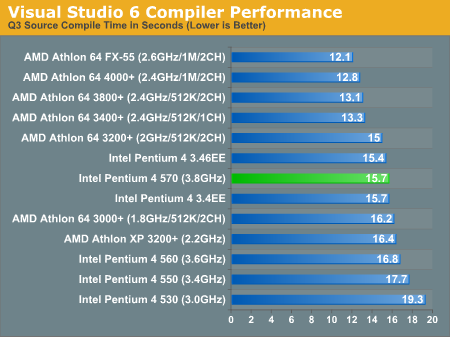
SPECviewperf 8
For our next set of professional application benchmarks we turn to SPECviewperf 8. SPECviewperf is a collection of application traces taken from some of the most popular professional applications, and compiled together in a single set of benchmarks used to estimate performance in the various applications the benchmark is used to model. With version 8, SPEC has significantly improved the quality of the benchmark, making it even more of a real world indicator of performance.
We have included SPEC's official description of each one of the 8 tests in the suite.
3dsmax Viewset (3dsmax-03)
"The 3dsmax-03 viewset was created from traces of the graphics workload generated by 3ds max 3.1. To insure a common comparison point, the OpenGL plug-in driver from Discreet was used during tracing.
The models for this viewset came from the SPECapc 3ds max 3.1 benchmark. Each model was measured with two different lighting models to reflect a range of potential 3ds max users. The high-complexity model uses five to seven positional lights as defined by the SPECapc benchmark and reflects how a high-end user would work with 3ds max. The medium-complexity lighting models uses two positional lights, a more common lighting environment.
The viewset is based on a trace of the running application and includes all the state changes found during normal 3ds max operation. Immediate-mode OpenGL calls are used to transfer data to the graphics subsystem."
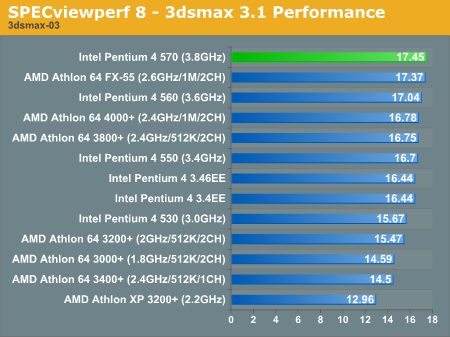
CATIA Viewset (catia-01)
"The catia-01 viewset was created from traces of the graphics workload generated by the CATIATM V5R12 application from Dassault Systems.
Three models are measured using various modes in CATIA. Phil Harris of LionHeart Solutions, developer of CATBench2003, supplied SPEC/GPC with the models used to measure the CATIA application. The models are courtesy of CATBench2003 and CATIA Community.The car model contains more than two million points. SPECviewperf replicates the geometry represented by the smaller engine block and submarine models to increase complexity and decrease frame rates. After replication, these models contain 1.2 million vertices (engine block) and 1.8 million vertices (submarine).
State changes as made by the application are included throughout the rendering of the model, including matrix, material, light and line-stipple changes. All state changes are derived from a trace of the running application. The state changes put considerably more stress on graphics subsystems than the simple geometry dumps found in older SPECviewperf viewsets.
Mirroring the application, draw arrays are used for some tests and immediate mode used for others."
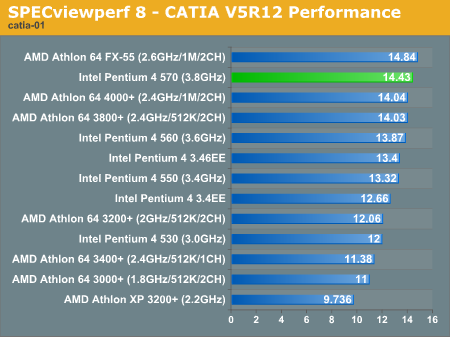
Lightscape Viewset (light-07)
"The light-07 viewset was created from traces of the graphics workload generated by the Lightscape Visualization System from Discreet Logic. Lightscape combines proprietary radiosity algorithms with a physically based lighting interface.
The most significant feature of Lightscape is its ability to accurately simulate global illumination effects by precalculating the diffuse energy distribution in an environment and storing the lighting distribution as part of the 3D model. The resulting lighting "mesh" can then be rapidly displayed."
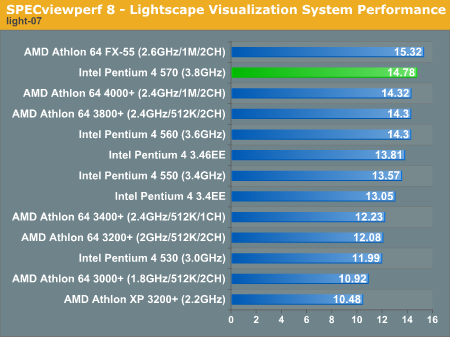
Maya Viewset (maya-01)
"The maya-01 viewset was created from traces of the graphics workload generated by the Maya V5 application from Alias.
The models used in the tests were contributed by artists at NVIDIA. Various modes in the Maya application are measured.
State changes as made by the application are included throughout the rendering of the model, including matrix, material, light and line-stipple changes. All state changes are derived from a trace of the running application. The state changes put considerably more stress on graphics subsystems than the simple geometry dumps found in older viewsets.
As in the Maya V5 application, array element is used to transfer data through the OpenGL API."
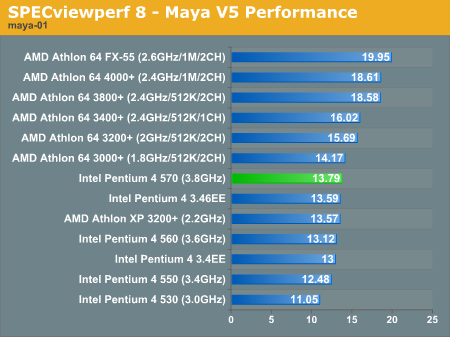
Pro/ENGINEER (proe-03)
"The proe-03 viewset was created from traces of the graphics workload generated by the Pro/ENGINEER 2001TM application from PTC.
Two models and three rendering modes are measured during the test. PTC contributed the models to SPEC for use in measurement of the Pro/ENGINEER application. The first of the models, the PTC World Car, represents a large-model workload composed of 3.9 to 5.9 million vertices. This model is measured in shaded, hidden-line removal, and wireframe modes. The wireframe workloads are measured both in normal and antialiased mode. The second model is a copier. It is a medium-sized model made up of 485,000 to 1.6 million vertices. Shaded and hidden-line-removal modes were measured for this model.
This viewset includes state changes as made by the application throughout the rendering of the model, including matrix, material, light and line-stipple changes. The PTC World Car shaded frames include more than 100MB of state and vertex information per frame. All state changes are derived from a trace of the running application. The state changes put considerably more stress on graphics subsystems than the simple geometry dumps found in older viewsets.
Mirroring the application, draw arrays are used for the shaded tests and immediate mode is used for the wireframe. The gradient background used by the Pro/E application is also included to better model the application workload."
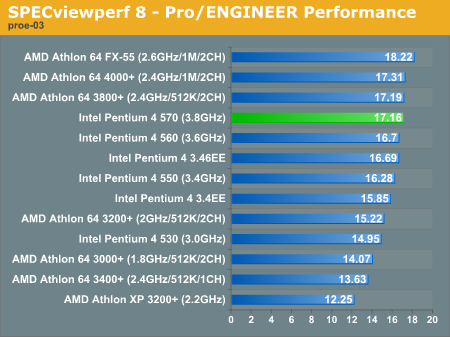
SolidWorks Viewset (sw-01)
"The sw-01 viewset was created from traces of the graphics workload generated by the Solidworks 2004 application from Dassault Systemes.
The model and workloads used were contributed by Solidworks as part of the SPECapc for SolidWorks 2004 benchmark.
State changes as made by the application are included throughout the rendering of the model, including matrix, material, light and line-stipple changes. All state changes are derived from a trace of the running application. The state changes put considerably more stress on graphics subsystems than the simple geometry dumps found in older viewsets.
Mirroring the application, draw arrays are used for some tests and immediate mode used for others."
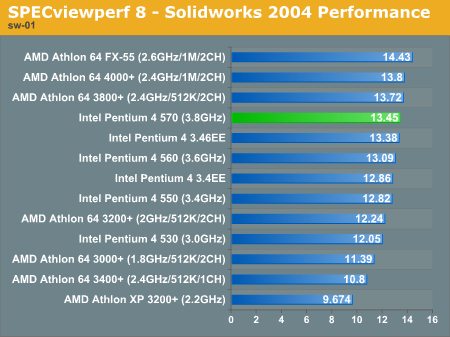
Unigraphics (ugs-04)
"The ugs-04 viewset was created from traces of the graphics workload generated by Unigraphics V17.
The engine model used was taken from the SPECapc for Unigraphics V17 application benchmark. Three rendering modes are measured -- shaded, shaded with transparency, and wireframe. The wireframe workloads are measured both in normal and anti-alised mode. All tests are repeated twice, rotating once in the center of the screen and then moving about the frame to measure clipping performance.
The viewset is based on a trace of the running application and includes all the state changes found during normal Unigraphics operation. As with the application, OpenGL display lists are used to transfer data to the graphics subsystem. Thousands of display lists of varying sizes go into generating each frame of the model.
To increase model size and complexity, SPECviewperf 8.0 replicates the model two times more than the previous ugs-03 test."
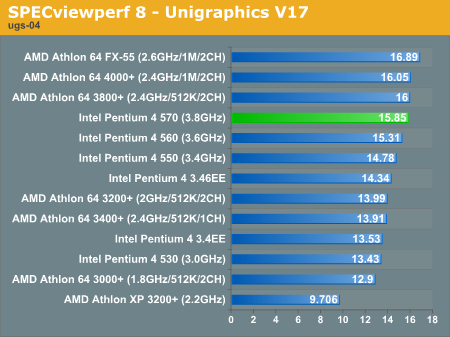










42 Comments
View All Comments
pplapeu - Wednesday, November 17, 2004 - link
why do you no longer overclock?you know users will do that. What if this processor was dialed up 10%, it would clock at 4.18Ghz and could run faster. I think the performance tales would be far different.
Staples - Monday, November 15, 2004 - link
Well the CEO did step down a few days ago. I hope we see better management soon. This is an embarrasment for Intel. Ever since the A64 came out, Intel has been releasing backseat products.IntelUser2000 - Monday, November 15, 2004 - link
No, its that most of you guys are AMD biased. Say Intel does release a high-performing Pentium M architecture based chip. Then you guys will just shut up and say nothing else. If AMD comes with 5% performance lead, AMD is thought of as GOD or something. Probably even greater. And about BTX, Pentium M does run pretty cool, but at 21W, that was equal to initial 0.18 micron P3's. Actually some of the DESKTOP P3's had ~15W TDP. I heard 286's and 386's had less than 5W TDP. Cooler, and faster is always better. Granted you may not need as much if your processor runs hotter, but still its necessary. It's also mentioned that since quiet PCs are gaining popularity, BTX can help a lot since it will allow graphics cards to have smaller fans.Another 3.8GHz P4 link: http://www.tomshardware.com/cpu/20041115/index.htm...
Quite contrary to their 3.6GHz throttling article, they seem positive towards 3.8GHz P4.
fawifewaewaf - Sunday, November 10, 2013 - link
diaff cretinmlittl3 - Monday, November 15, 2004 - link
#35,Do you know that the long post of #21 is the author of the article you just read (which is way longer than any post) and the owner of Anandtech? Do you see the post is from ANAND Lal Shimpi? And that his post was in response to the other long post which Anand saw as important enough to respond to.
I enjoy all the comments on this site, long and short. It gives readers a sort of "behind the scenes" look at hardware and software. I think there should be no restrictions as it currently stands.
Keep 'em coming. Go Anandtech :)
bob661 - Monday, November 15, 2004 - link
Based on #32's link, it would seem that the P4's would decrease in performance during sustained use with an average user. So unless you're an enthusiast, you would not see the full performance of any of the new P4's.Alphafox78 - Monday, November 15, 2004 - link
There should be a size limit on posts...GTMan - Monday, November 15, 2004 - link
Does the EDB functionality lower system performance when it is turned on?Auteur - Monday, November 15, 2004 - link
#12:The only reason HardOCP uses DVD2AVI in their bench marking suite is its the only Divx front end that runs faster on AMD cpu's than Intel's. Its a dead app (the author no longer updates it) that can't IVTC, deinterlace, clean or sharpen video. Its great for demuxing audio and thats it.
Intel's chips dominate when you use the popular front ends like AutoGK, Gordian Knot or Xmpeg. Read Doom9's forum if you don't believe me.
langles - Monday, November 15, 2004 - link
Did you read the article at Tom's Hardware this weekend about the thermal issues with the Pentium 4 3.6 GHz?http://www.tomshardware.com/cpu/20041114/index.htm...
"The Heat Can Cause Intel's P4 To Throttle And Damage Over Time"
I would expect that this issue is even worse for the 3.8 GHz.